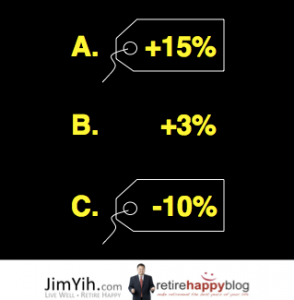Buy low, sell high

If you think about it, Buy Low, Sell High is the secret to investing. Logically, it’s tough for anyone to refute that statement. So why is it so hard to do? It’s simply because psychology gets in the way. I’ve said many times that when it comes to money, psychology is more powerful than logic.
Psychologically, we think we can time the peaks and valley’s but really we can’t.
If you buy something for $1.00 and it goes up to $1.25, did you make money? What if you bought something at $1.50 and it goes to $2.50, did you make money?
What if you bought at $3.00 and it goes up to $4.00 and you sell it but it keeps going up to $4.50? Are you happy that you made money or are you upset that you sold too early?
In my experience, I hear people talk about the opportunities missed all the time because they bought too early or sold too late when they should focus more on the fact that they made money.
Investors need to stop trying to hit the top and bottom of market movements. I hate to break it to you but it’s just impossible to do on a consistent basis. If you’ve done it, it probably was due to luck than the ability to predict it with any degree of accuracy.
Buy high, sell low
Another psychological phenomenon that often occurs is the tendency to buy high and sell low which is the opposite of the proper and winning strategy. Imagine, for example, you get your investment statement in the mail and your three different investments look like this:
- Investment A = +15% return
- Investment B = +3% return
- Investment C = -10% return
What does your gut instinct tell you to do?
For most people, the natural instinct is to turf the loser (Investment C) and keep the winners (Investment A and B). If you do this, you are in fact practicing the wrong strategy: SELL HIGH, BUY LOW.
What is happening here is something called linear extrapolation. We tend to think in straight lines. When investments go up, we think they will keep going up. When investments are winners, we think they will always be winners. When investments go down, our biggest fear is they will keep going down. No one wants a loser so we assume the trend might continue and want out.
Trends or commodities?
The main problem with investing is we tend to think of investments as trends and not the commodities they are. If we looked at investments like commodities, we might look at them a little differently Check this out:
Which commodity would you buy?

You see if these were price tags were attached to toilet paper, pads, shoes or couches, we would choose the one that is 10% off because we are conditioned to buy on sale. Maybe we need to trick our brains to buy drawing price tags around performance figures to help us BUY LOW, SELL HIGH.
Rebalancing is the key to BUY LOW, SELL HIGH
Let’s imagine these three investments as a portfolio.
- 30% Investment A = $3,000
- 50% Investment B = $5,000
- 20% Investment C = $2,000
- Total Investment = $10,000
If Investment A makes 15%, Investment B makes 3% and Investment Closes 10% then the portfolio will look like this:
- 33% Investment A = $3,450
- 49% Investment B = $5,150
- 17% Investment C = $1,800
- Total Investment = $10,400
Now the portfolio is out of balance from the original allocation. If we rebalance the portfolio, we would:
- Sell $330 of Investment A
- Buy $50 of Investment B
- Buy $280 of Investment C
Rebalancing forces us to BUY LOW, SELL HIGH without guessing, forecasting, predicting or speculating. Rebalancing is a disciplined strategy that increases returns and takes the guesswork out of investing. What do you think of this logic?
Comments
What do I think about this logic? I think rebalancing is the very definition of “buy low sell high”. If you’re buying and selling financial instruments on anything other than that then you’re pretty much guaranteeing that you’re going to buy high and sell low.
When equities (or generally, mutual funds) go high, take some of that money and put it into bonds. that’s hard, everyone’s earning 12% and talking about how great they’re doing, and you’re taking money out of those investments and putting them into low performers. Then when markets crash, you’re moving money from nice safe bonds over into equities that just crashed. That’s really hard to do to.
But if you buy when the markets are down, and sell when the markets are high then, yeah, that’s buying low and selling high.
Perfect article. And great reply above. This strategy is what I try to follow, but, I agree, it isn’t always easy. With the volatility of the 2020 market, there are great opportunities with all the mini crashes and gains that are happening. Thanks for the advice.